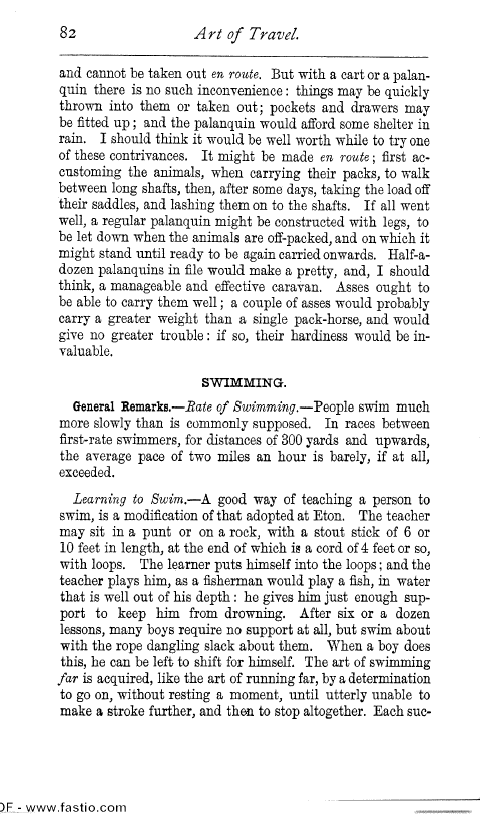| ||||||

OCR Rendition - approximate82 Art of Travel. and cannot be taken out en route. But with a cart or a palanquin there is no such inconvenience : things may be quickly thrown into them or taken out; pockets and drawers may be fitted up ; and the palanquin would afford some shelter in rain. I should think it would be well worth while to try one of these contrivances. It might be made en route ; first accustoming the animals, when carrying their packs, to walk between long shafts, then, after some days, taking the load off their saddles, and lashing them on to the shafts. If all went well, a regular palanquin might be constructed with legs, to be let down when the animals are off packed, and on which it might stand until ready to be again carried onwards. Half-adozen palanquins in file would make a pretty, and, I should think, a manageable and effective caravan. Asses ought to be able to carry them well ; a couple of asses would probably carry a greater weight than a single pack-horse, and would give no greater trouble : if so, their hardiness would be invaluable. SWIMMING. General Remarks.-Bate of Swimming.-People swim much more slowly than is commonly supposed. In races between first-rate swimmers, for distances of 300 yards and upwards, the average pace of two miles an hour is barely, if at all, exceeded. Learning to Swim.-A good way of teaching a person to swim, is a modification of that adopted at Eton. The teacher may sit in a punt or on a rock, with a stout stick of 6 or 10 feet in length, at the end of which is a cord of 4 feet or so, with loops. The learner puts himself into the loops ; and the teacher plays him, as a fisherman would play a fish, in water that is well out of his depth : he gives him just enough support to keep him from drowning. After six or a dozen lessons, many boys require no support at all, but swim about with the rope dangling slack about them. When a boy does this, he can be left to shift for himself. The art of swimming far is acquired, like the art of running far, by a determination to go on, without resting a moment, Until utterly unable to make a stroke further, and then to stop altogether. Each suc )F - www.fastio.com |